In Year 35 of this retrospective, I wrote a post called One for the Ages, in which I showed my lifetime masterpiece, Mackenzie-Pruess. In that game I debuted a new opening variation, the Bryntse Gambit (which had been played before in correspondence chess but never, to my knowledge, in OTB chess). The Bryntse Gambit is The Most Fun Opening in Chess, in which White sacrifices his queen on move six (!) to obtain an essentially unstoppable initiative. In that game I defeated Pruess, who was an International Master and, at the time, one of America’s top young players.
It took eight years for me to get the opportunity to play the Bryntse again, and when I finally did, it was in almost an identical situation. Same tournament: the Western States Open in Reno. Same round: round six, the money round. This time I went into the round with a score of 3.5-1.5 and a chance to tie for first place in the tournament, if I won. Even a draw would clinch the under-2300 prize.
But I would have to get past Grandmaster Sergei Kudrin, who had a 2608 rating, was a multiple-time winner of the Western States Open, and most importantly was a Grand. Master. That’s very important because I had (and have) never in my life beaten a GM. It’s probably the biggest thing left on my chess “bucket list.”
My last sentence probably gives away the fact that I didn’t win this game. I only drew it, and for that reason it does not compare with the Pruess game as a career highlight. Nevertheless, it is an extremely hard-fought and interesting game, a worthy companion piece to Mackenzie-Pruess, and an important game for anyone who wants to study or play this amazing opening variation.
Surprisingly, I have never given a full annotation of the Mackenzie-Kudrin game in this blog. Again, it’s because at the time I gave a ChessLecture on it and I didn’t want to duplicate the lecture. I will now rectify the omission, and even if you already heard my lecture, I still have some new things to say.
Dana Mackenzie — Sergei Kudrin, 10/19/2014
1. e4 c5 2. f4 d5 3. Nf3 …
The Bryntse Gambit, named after Arne Bryntse, a Swedish correspondence champion who pioneered it in the 1960s. It’s sort of a Budapest Gambit in reverse.
3. … de 4. Ng5 Nf6 5. Bc4 Bg4?! 6. Qxg4! …
This queen sacrifice is for me the main reason for playing 4. Ng5. Otherwise I would play 4. Ne5, which is also a very interesting move. Note that Black can avoid the queen sacrifice by simply playing 5. … e6. That is one reason I had to wait eight years for another chance to play this line.
In some places I have seen this gambit described as “dubious.” What can I say? I’ve played three tournament games with it: a win against a class-B player, a win against an IM rated 350 points above me, and a draw (this game) against a GM rated 400 points above me. Are these the kinds of results you would expect from a “dubious” opening?
6. … Nxg4 7. Bxf7+ Kd7 8. Be6+ Kc6 9. Bxg4 e6 10. Nc3 Nd7
I have given the first few moves with almost no comment, because I have written about them many times in this blog and elsewhere. I don’t want to turn into a bore. However, it’s time to wake up because Kudrin’s move is (for me, at least) a TN.
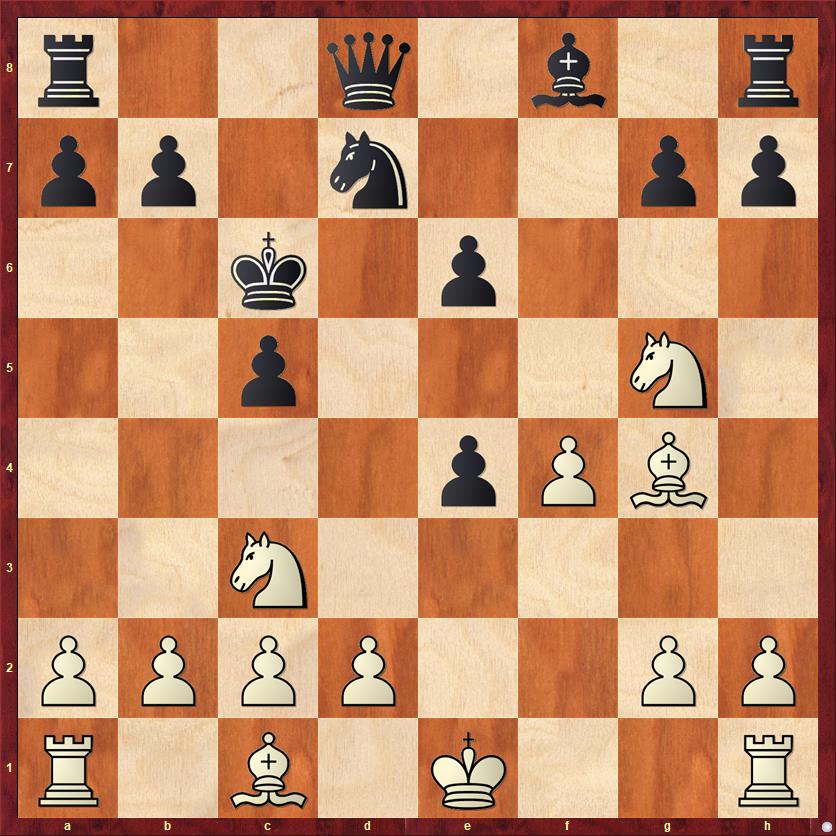
FEN: r2q1b1r/pp1n2pp/2k1p3/2p3N1/4pPB1/2N5/PPPP2PP/R1B1K2R w KQ – 0 11
Black’s tenth move diverges from Mackenzie-Pruess. David played 10. … Na6, which the computers all agree is a stronger move than the one that Kudrin chose. In a way David was unlucky; because he played what the computer considers the “right” move, I was very well prepared against it. Because Kudrin played the “wrong” move, I was now in unfamiliar territory: the computer had never played 10. … Nd7 against me.
Nevertheless, I had a very good idea of how to proceed. In my post on the Pruess game I outlined the Five Commandments for White in the Bryntse Gambit. Those commandments are just as applicable in the 10. … Nd7 line as in the 10. … Na6 line, and as you will see I stuck to them faithfully. In fact, I drew (and should have won) primarily because I knew the Commandments and Kudrin didn’t. The Commandments are:
- Thou shalt not open files.
- Thou shalt exchange one of thy knights for Black’s bishop.
- Thou shalt keep Black’s queen under lock and key.
- Thou shalt not covet thy opponent’s material. (Or, “Thou shalt not cash in too soon.”)
- Thou shalt be patient, for time is on thy side.
Now I have to tell the truth: I did not get an advantage out of the opening this time. We’ll see that Kudrin missed a very good move on move 18, which would have given him the advantage. So we must ask what White could do to improve, and why the computer thinks that 10. … Nd7 is so much worse than 10. … Na6. The answer (according to Fritz) is that 11. Bxe6 immediately equalizes.
I don’t know if I agree. This move violates Commandment 5 for sure, and probably Commandment 1 as well. I prefer to take the e4 pawn but blockade the e6 pawn, because that keeps the position (and in particular the e-file) closed. After 11. Bxe6, if I later capture on e4 then the position and the e-file will be wide open, and this favors Black’s queen and his rooks.
I agree that 11. Bxe6 needs to be tested. We can’t discard the computer’s advice completely. But it makes me uneasy; as White, I don’t know if I can trust this move.
11. Ncxe4 Nf6 12. Bf3 Nxe4 13. Bxe4+ Kb6 14. d3 …
Here Fritz significantly prefers 14. a4. Aside from 11. Bxe6, this seems to be the main computer suggestion for improving White’s play in this opening. The idea is just to turn up the heat on Black’s king a little bit, to threaten a5+ and maybe even march the pawn to a6.
I didn’t play 14. a4 because my conception of White’s strategy has never included a quick, all-out assault against Black’s king. Instead, I was just playing simple developing moves. And I think that is a reasonable approach for the first time you play a variation. Next time, if there ever is a next time, I will try 14. a4 (unless I play 11. Bxe6 first!).
By the way, notice that I am not even tempted by a move like 14. Nf7, which would violate Commandment 4 (don’t cash in too soon).
14. … Qe8 15. Be3 Kc7 16. O-O h6 17. Nf3 Bd6 18. Rae1 …
This was a big decision for me. I really wanted to play 18. Ne5 but it violates Commandment 1: after 18. … Bxe5 19. fe Qe7 Black gets an open f-file for his rooks. I also thought seriously about 18. d4, but it seemed too risky and premature. It violates Commandment 5, to be patient. I finally decided to just continue developing and put my rook on the e-file, where it will eventually put pressure on the isolated e-pawn.
However, it’s possible that 18. g3 would have been a better choice. I played it on the next move anyway, and if I had played it first, then (spoiler alert) 18. … g5 would have been less effective. White would be able to play 19. fg hg 20. Nxg5, which was not possible in the game.
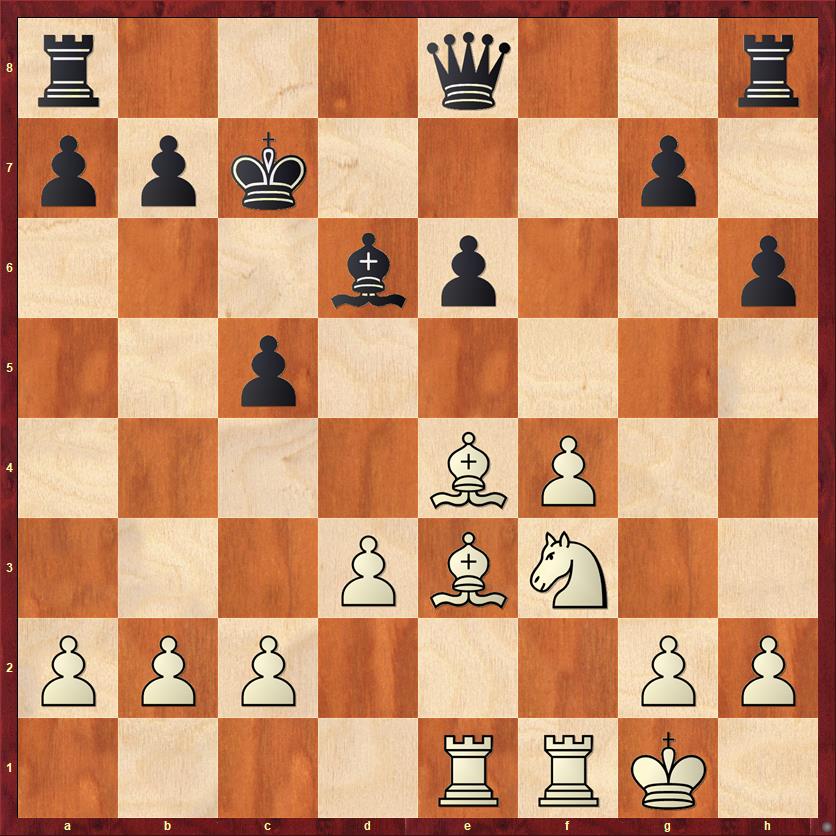
FEN: r3q2r/ppk3p1/3bp2p/2p5/4BP2/3PBN2/PPP3PP/4RRK1 b – – 0 18
This is a very interesting position, because it’s the one place where I believe Kudrin missed a chance to get a clear advantage. If he had known the Five Commandments, he would have known how important it is for White to keep the position closed, and he would have realized that this is a great opportunity for Black to blast the position open, at the cost of a pawn, with 18. … g5! 19. fg hg 20. Bxg5 Qh5 21. h4. White’s position is barely holding together. Notice that none of White’s minor pieces can move, while Black can bring his remaining rook over to f8 or g8. The kingside has turned into the Critical Zone, and Black has a tremendous amount of firepower there, while his own king is completely safe on the queenside.
Why did Kudrin miss this? I think the reason was largely psychological. He still has the mindset that he is rated 400 points above me, that White has played a stupid and unsound opening, and that Black should win if he simply plays calm chess and develops his pieces in a normal fashion. As we’ll see, he was quite mistaken. If Black does not play energetically, White will obtain a complete bind on the position.
As you’ll see, I was very attuned to the danger presented by Black’s … g7-g5 pawn break, and over the next few moves my main goal was to shut it down.
18. … Rd8? 19. g3 Kb8 20. Bd2 …
The goal is to get my knight to e5, without allowing the opening of the f-file.
20. … Qe7 21. Bc3 Rhf8 22. Ne5 Bxe5 23. Bxe5+ …
Mission accomplished! Also notice that by trading my knight for the bishop I have checked off Commandment 2. Once I get the two unopposed bishops, they are essentially as strong as Black’s rooks. This is a fact that Kudrin probably did not anticipate. His only comment to me after the game was, “Two bishops, very strong.”
23. … Ka8 24. Bg6 …
Shutting down the … g7-g5 pawn break.
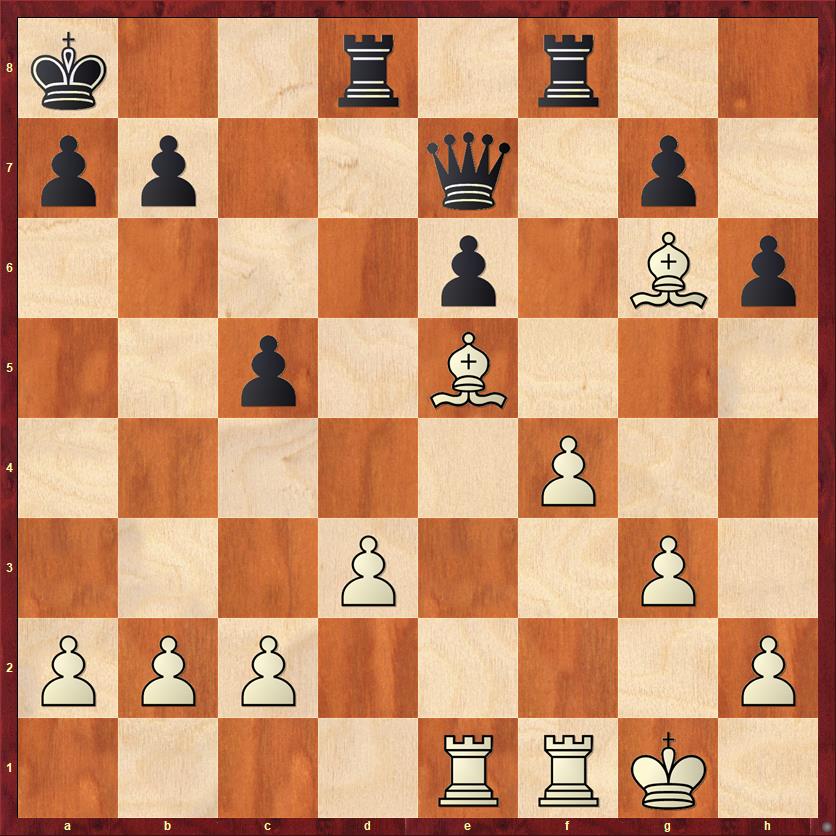
FEN: k2r1r2/pp2q1p1/4p1Bp/2p1B3/5P2/3P2P1/PPP4P/4RRK1 b – – 0 24
Another key moment in the game. Although I have shut down one pawn break, Black does have another pawn break in this position, and the chess engines think that now is the time for him to play it: 24. … c4! The main idea is that after 25. d4 Qb4 26. b3 cb 27. ab Rxd4! 28. Bxd4 Qxd4+ Black certainly has taken the initiative, and White is at best fighting for a draw.
My thinking about this has changed since my ChessLecture. I agree that 24. … c4 is a move Black should think seriously about. It’s the same principle as on move 18 — Black needs to open lines in order to get any sort of counterplay. However, Black’s next move, 25. … Qb4, is not the sort of move that makes me quake in terror. What is the queen doing here? Just tickling the b-pawn and trying to set up a cheapo sacrifice on d4. But instead of playing into his hands with 26. b3, I can avoid creating any weaknesses with 26. Rb1. This will be followed up with c3, chasing the queen away and fortifying the d-pawn, and I will gradually re-establish the sort of impregnable fortress that I’m aiming for. The position might be slightly better for Black than the game, but it’s not drastically different. Remember Commandment 5: Time is on my side.
Anyway, Kudrin is still under the mistaken impression that his extra material will just win the game automatically. It won’t. Over the next few moves his position gets more and more lifeless.
24. … Rd7 25. Re4 …
I don’t want to give him a second chance to play … c4! Among other things, this game is a great example of prophylaxis. White systematically takes away Black’s chances for counterplay.
25. … a6 26. h4 Qd8 27. a4 …
More prophylaxis.
27. … Rf6
Kudrin is starting to see that he won’t get anywhere without offering up a little bit of material.
28. h5! …
Commandment 4. I have no interest in grabbing the exchange with 28. Bxf6 Qxf6 29. h5 Qxb2, which allows Black to activate his queen and damage my pawn structure.
28. … Qb6
I was hoping for 28. … Rxg6 29. hg Qe8 30. f5 ef 31. Rxf5, when Black has back-rank issues (in spite of his attempt to avoid them with 25. … a6). For example, 31. … Qxg6 32. Rf8+ Ka7 33. Bb8+ Kb6 34. R8e8! However, the computer comes up with the remarkable 31. … b6!, giving luft to the king. I still can’t defend my g-pawn, so Black is probably a bit better here. 31. … b6 is the sort of quiet move, four moves deep into a tactical variation, that is really hard to see over-the-board.
29. Kg2 Rd4
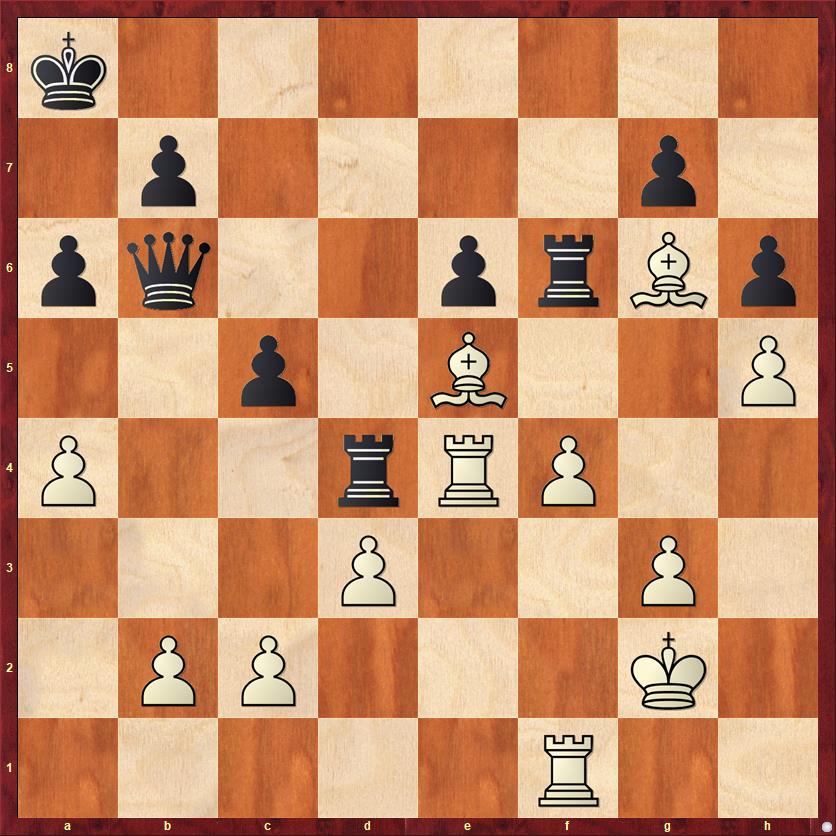
FEN: k7/1p4p1/pq2prBp/2p1B2P/P2rRP2/3P2P1/1PP3K1/5R2 w – – 0 30
The most picturesque moment of the game. Kudrin dangles all of his rooks in front of my bishops, trying to persuade me to take one of them. But I refuse to do so! Actually I probably could get away with playing 30. Bxd4 cd, but I was afraid that there would be some mischief on the c-file. In the end I stuck with Commandment 4 (Don’t cash in too soon!). I didn’t see any good reason to trade off my beautiful bishop for a useless rook, unless I absolutely had to.
30. b3! Rxe4 31. Bxe4 Rf7
Chastened, the rook creeps back into its hole.
32. Bc3 …
More prophylaxis, keeping the queen out of the dark squares (Commandment 3) while preparing to bring the rook to the e-file. Black’s complete paralysis is becoming more and more apparent. The only problem for White is that it’s not really clear what my winning plan is. I still have “only” two bishops and a pawn for the queen. There are tons of weak points in Black’s position, though: e6, g7, c5, b7. Basically my plan is to keep pressure on all these points, wait and see what develops. Time pressure is also going to become a factor. We were both getting low, but Kudrin’s time pressure was worse than mine.
32. … Qd8 33. Re1 Rd7 34. Bf3 Re7 35. Re5 Qd6 36. Bb2 …
Looking to increase the pressure on c5. I knew that this was a bit of a risk because Black could try … c4 here.
36. … Rc7 37. Re4 Re7 38. Re5 …
Chess psychology and the clock situation are all playing a role here. A better move for White would be 38. Be5!, which might be followed by 38. … Qb6 39. Rc4 when both b4 and d4 are threatened. Fritz comes up with an insane defense: 39. … Rd7 (preventing d4) 40. b4 Ka7 41. bc Qb1! (an important point: Black is finally getting some queen activity) 42. c6 bc 43. Bxc6 Qd1!! 44. Bxd7 Qe2+ with a perpetual check. I don’t quite know whether to believe this, but even if it’s true, a line like this would be impossible for a human (even GM) to find in a time pressure situation, with less than a minute left to make three moves.
With 38. Re5 I am showing a possible willingness to accept a draw by repetition. I’m not sure whether I would have actually taken a draw if he had played 38. … Rc7; it’s possible that I would then have played 39. Re4 Re7 40. Be5, going into the line above. However, Kudrin has to take the possibility of a draw very seriously. To understand the last ten moves of the game, for both players, you have to understand the tournament situation. I’m essentially playing this game with draw odds. If I draw, I know I will win a big money prize for top under-2300 player. Kudrin, being a 2600 player, is not eligible for that prize. For him, as a professional chess player, it’s win or bust. If he wins, he ties for first and gets a decent payday. If we draw, he would get less than $100 — not even enough to cover his entry fee. (Titled players do not have to pay an entry fee in advance, but if they win a prize, the entry fee is deducted from it.)
So for Kudrin, a draw is absolutely not acceptable, and he has to look for a different plan than 38. … Rc7. That explains his next two moves, which came as a great surprise to me.
38. … a5 39. Bc3 Ka7?!
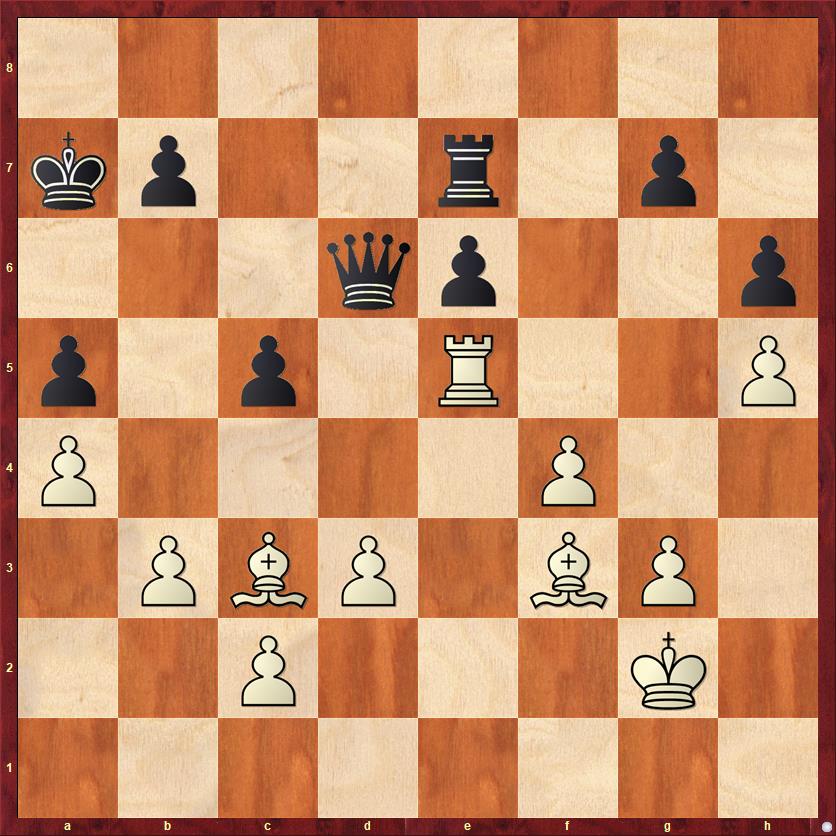
FEN: 8/kp2r1p1/3qp2p/p1p1R2P/P4P2/1PBP1BP1/2P3K1/8 w – – 0 40
What?! He’s just giving me a free pawn? Well, no, it isn’t free. Kudrin has finally decided that it’s time to sacrifice a pawn to activate his queen. If he had played 39. … Qc7 or 39. … Qb6, I haven’t found a way to force the win of a pawn. I think that the game would have ended in a draw because Black has no threats either. With 39. … Ka7 Kudrin turns up the risk-reward dial for both sides. We’re now playing for “three results” — a White win, a draw, or a Black win are all possible. His risk of losing is now greater than it was, but he had to do it in order to have a realistic shot at first place.
40. Bxa5 …
Unlike my earlier chances to win material, on moves 27-29, I had no qualms about taking the material this time. I thought I was simply winning.
40. … Qd4
Both sides are past the time control now, and things are about to get interesting. By taking on a5 I violated Commandment 3. Kudrin’s queen will now penetrate to my back rank, and the question is whether she can cause enough mischief there to frustrate my attempts to win the endgame.
41. Be1 b6 42. a5 Qb2!
Of course, 42. … ba 43. Bf2 would win for White.
43. ab+ …
To me, this was almost a no-brainer. I wanted to rip away the barrier of pawns and expose Black’s king. So it was surprising to me when I went over the game with my friend Gjon Feinstein, and for him 43. b4 was a no-brainer! It just shows how different people can have different conceptions in chess. I think that 43. b4 is very much a Gjon move because it ratchets the tension up to almost unbearable levels, and really takes the position to a place that is beyond human comprehension. I will skip the computer analysis and just leave it as a question for the reader: which is better, 43. ab+ or 43. b4 — or does it not really matter?
43. … Kxb6 44. Bf2! …
This move seemed very efficient to me. I don’t need to worry about 44. … Qxc2 because 45. b4! is now decisive. After 45. … Rc7 46. bc+ followed by 47. Rxe6 White’s queenside pawns are off to the races. Or if 45. … Re8 46. Rxc5 White threatens two devastating discovered checks, and Black can’t defend them both.
44. … Rc7 45. Rxe6+ …
It’s always exciting in the Bryntse Gambit when, 39 moves after the initial queen sacrifice, you get back to material equality. Here, Q vs. 2B + 3P.
45. … Kb5 46. Re2 Qa1?
A serious mistake. Black needed to maintain contact with the c-pawn by playing 46. … Qb1. After that White has winning chances but I doubt that he has a forced win. The computer rather adamantly evaluates the position at 0.00, but that is too black-and-white an evaluation for such a complicated position.
47. Be1? …
Failing to take advantage of the opportunity to improve the position of my rook with 47. Re4! followed by 48. Rc4, when White is probably winning. On c4 the rook is able to combine attack with defense. One of the pawn breaks b4 or d4 is coming, and White will be able to get connected passed pawns on the queenside.
47. … Qf6?
Boy, both players just collapsed at the end. I guess the difficulty and strain of the game was too much for us.
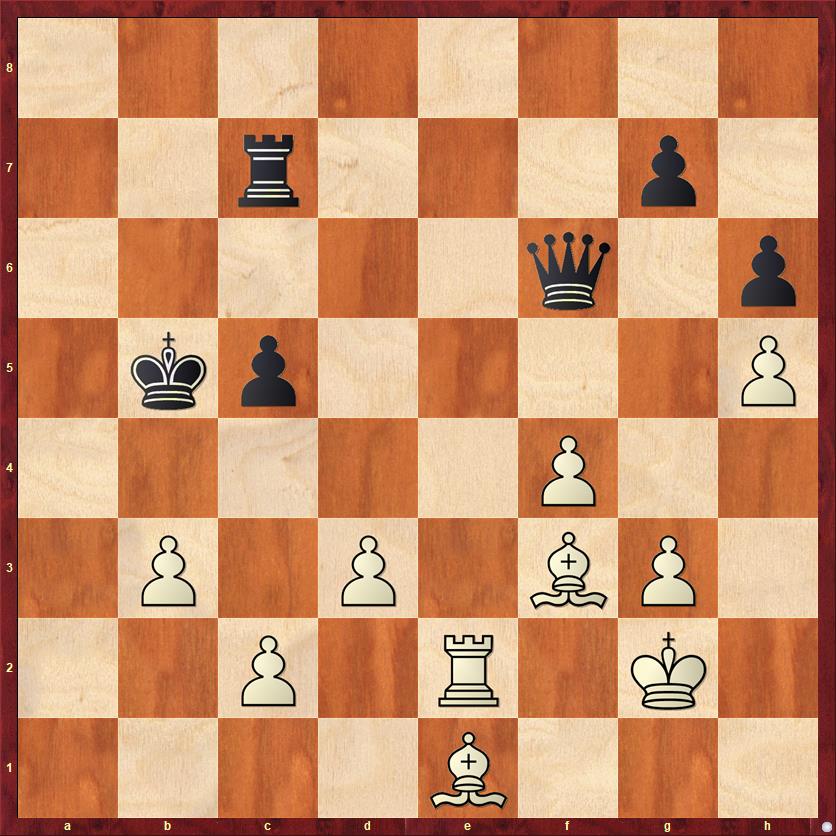
FEN: 8/2r3p1/5q1p/1kp4P/5P2/1P1P1BP1/2P1R1K1/4B3 w – – 0 48
Black’s move was both very poor and very smart. It’s poor because after sacrificing two pawns to activate his queen on my back rank, he voluntarily relinquishes that activity. The smart thing, though, was that he accompanied this bad move with a draw offer!
While I considered his offer, I thought about a million different things. The prize money that I would win for sure if I accepted his offer. My “bucket list” wish to beat a grandmaster — this was surely the best opportunity I would ever get. The clock, because this will likely come down to a long and very technical endgame, and we are now in a sudden-death control, each of us with about 35 minutes left. Among all of these considerations, I forgot to do the most important thing: look at the chessboard.
It’s a known phenomenon that draw offers are often accompanied by inferior moves, and I had to at least think about the possibility that 47. … Qf6? might be a game-losing blunder. Indeed, after 48. c4+! Kb6 (this is forced because 48. … Ka6? 49. Ra2+ Kb6 50. Ba5+ Ka7 51. Bxc7+ is near-mate: something I definitely did not see) 49. b4! is crushing. Black cannot take because 49. … cb 50. Bf2+ either leads to mate or the win of Black’s rook after 50. … Rc5 51. Re5. After 49. … Rd7 50. bc+ Kxc5 51. Re5+ the computer shows White with a 5-pawn advantage.
Even so, these computer-proclaimed 5-pawn advantages can be very misleading. With one false step by White it can drop to a 1-pawn advantage or a draw — and especially when Black has a queen, there will be lots of ways to go wrong. In view of everything, I think it was not unreasonable for me to take the draw offer. My only regret, really, is that I did not calm down and control my emotions enough to see the mate threats after 48. c4+ and 49. b4. That might have given me the courage to play on. But instead…
48. Draw agreed.
Obviously this game can’t compare with Mackenzie-Pruess. Even if I had won, it wouldn’t have been quite as convincing. The Bryntse Gambit gets an A- in this game. I was never really in trouble, but I also never had an actual advantage until move 46. My possible improvements on moves 11 and 14 need to be tested. The Five Commandments get an A+ in this game. They enabled me to play the first 40 moves with conviction, and Kudrin was seriously hampered by the fact that he didn’t know the Five Commandments. He should have watched my ChessLecture! My courage and emotional self-control get a B-; great for the first 40 moves, but very wobbly at the end. Kudrin’s play was surprisingly poor and gets a B. He missed chances early on, didn’t properly appreciate the need for Black to play energetically and open lines, and then really messed up on his last two moves. His draw offer gets an A for perfect timing, but of course he couldn’t be too happy with that for the reasons I’ve explained. Finally, White’s two bishops get an A+++++! Bishop lovers everywhere should rejoice in this game.



{ 1 comment… read it below or add one }
Offtopic…
Dana, I sent you an email about a chess book. Did you receive it?
R.